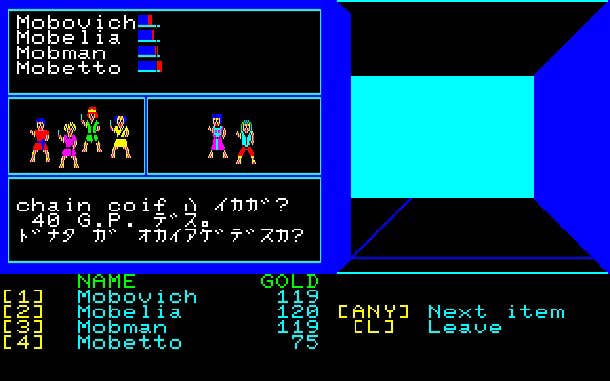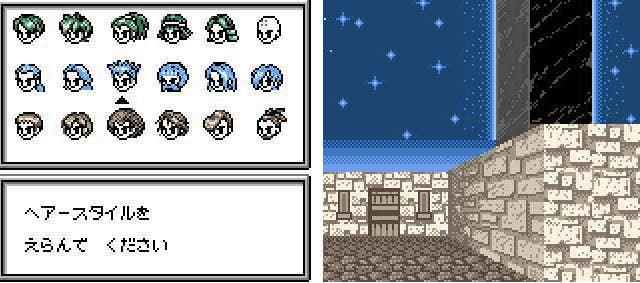Daily Classic: The Black Onyx, Japan's Role-Playing Game Missionary
30 years ago, a Dutch designer brought Canadian RPG design into Japan and launched a revolution.
This article first appeared on USgamer, a partner publication of VG247. Some content, such as this article, has been migrated to VG247 for posterity after USgamer's closure - but it has not been edited or further vetted by the VG247 team.
The Daily Classics series returns this week to explore key role-playing games celebrating anniversaries this year. First up, Bullet-Proof Software's The Black Onyx, which debuted on PC-8801 in 1984.
Mission work has been a fixture of Christianity since its very beginning: Go forth, share the good word, convert the unbelievers. Some cultures have been receptive, others haven't. The Japanese, for example, infamously crucified 26 missionaries in the 16th century.
Many cultures have embraced Christianity on their own terms, mixing it with elements of indigenous religions to create a strange new hybrids of faith that combine, for example, imported Christian beliefs expressed by way of voodoo practices. That's probably not precisely what Jesus had in mind when he exhorted his followers to make disciples of all nations, but hey — whatever works.
Which brings us back to Japan, which may have rejected Christianity but has otherwise proven to be anything but impervious to Western influences, especially in the past century or so. Some Western missionary efforts have done quite well in Japan. It all depends on the subject matter.
By far one of the most effective efforts to bring Western concepts to Japan came from a Dutch game enthusiast by the name of Henk Rogers. While best known for the role he played in ushering the legendary puzzle game Tetris out of the Soviet Union, by the time he helped fill the world's mind with visions of relentlessly falling tetrominoes, Rogers had already played an instrumental role in getting the Japanese hooked on role-playing games. These days, the words "Japan" and "RPG" are practically synonymous, but back in 1984 that was hardly the case.
Whether you see the first proper instance of the modern vision of the computer RPG as 1981's Wizardry or 1983's Ultima III: Exodus, the genre had been doing quite well for itself in the U.S. and Canada, building on the success of Dungeons & Dragons. But given the complexity of the genre and its reliance on text, the format was understandably slow to emigrate to the East. D&D itself didn't make its way to Japan in an official capacity until 1985; up until that point, only genuine enthusiasts — those truly dedicated to the cause of nerddom, language barriers be damned — played tabletop RPGs.

Japanese game developers were aware of RPGs and even dabbled in rudimentary forms of role-playing design as early as 1982. Those early efforts were fairly dismal by modern standards, with opaque mechanics and nothing even slightly resembling game balance. The spirit was willing, but the proverbial flesh was terribly weak.
At least, that was true until Rogers came along to preach the gospel of role-playing games with The Black Onyx in 1984. Though hardly the most spectacular take on the RPG concept — it was essentially Wizardry with some modest mechanical tweaks — it was the work of a designer who had obsessed over the genre in his native language and understood the ins and outs of role-playing. In fact, Rogers' language problem mirrored that of his target audience: He understood the games, but not Japanese.
With the help of some native speakers, Rogers managed to cram a proper computer RPG experience into a format friendly to Japanese gamers. Released exclusively for the PC-8801 personal computer, The Black Onyx overcame a slow start (thanks in large part to an active PR campaign by Rogers) to become a bonafide hit, racking up impressive sales and a ton of awards by the end of 1984. In short order, the game made its way to a number of other systems, including Sega's SG-1000 console, where it received a visual facelift courtesy of future Phantasy Star designer Reiko Kodama.

Just as certain Japanese properties have become far more successful in the West than in their native land — Metroid, Castlevania, and Sonic the Hedgehog come to mind — the reverse has occasionally been true as well. Lode Runner and Spelunker, for example, have seen far more sequels and far better sales in Japan than here in the States. The Black Onyx doesn't quite fit that definition, having been developed in Japan for the Japanese by a European designer, but it certainly serves as a sort of conceptual bridge. The franchise has long since faded to obsolescence even in Japan; due to rampant cloning by Japanese developers, only one of the two planned sequels saw the light of day as Rogers' Bullet-Proof Software was shut out of the market it helped create. Yet its legacy lives on.
Perhaps no Western franchise has seen more dramatic Japanese adoption than Wizardry. The series effectively died in the West nearly 15 years ago after its original developer, Canada's Sirtech, dissolved. In Japan, however, the series still soldiers on with new sequels and remakes on a nearly annual basis... and all thanks to The Black Onyx. Rogers' creation introduced countless Japanese developers and enthusiasts to the rich underpinnings of proper role-playing game design and turned them on to the genre. RPG luminaries such as Kodama and Dragon Quest creator Yuji Horii cut their teeth on The Black Onyx and became interested in Wizardry and eventually in creating their own takes on the genre.
In other words, The Black Onyx sowed the seeds for Japan's entire RPG boom, directly paving the way for Dragon Quest, which in turn established role-playing games as the most popular genre in the country. Today, RPGs dominate Japan's sales charts: Dragon Quest, Monster Hunter, Pokémon, Shin Megami Tensei, among others. The fact that The Black Onyx and Wizardry arrived in Japan before D&D itself means they served as the inflection point for Japanese RPG design, which goes a long way toward explaining why the JRPG often strays so far from elements that Western RPG designers consider sacrosanct. Like those Voodoo-inspired reinterpretations of Christianity, Japanese RPG designers took the teachings of a foreign culture and created something uniquely their own.

The Black Onyx had quite a ripple effect in other ways as well. Playing John the Baptist to the coming messiah that was Wizardry didn't simply introduce an entire country to its future favorite video game genre, it also strengthened the flow of Japanese pop culture into the West. Wizardry co-creator Robert Woodhead was so taken by the warm reception he and his work received in Japan that he soon began to spend much of his time and energy there, establishing a company called AnimEigo. As one of first major importers of anime into the U.S., AnimEigo helped fuel America's '90s anime boom with classic releases like Bubblegum Crisis, Urusei Yatsura, Kimagure Orange Road, and more.
All of this from a single game by a Dutch designer who didn't even speak Japanese. Though The Black Onyx has long since become a footnote in history, its role of missionary can't be overstated: Bringing the enlightenment of turn-based statistics-driven combat to the citizens of a foreign land. And this time around, no one had to be crucified.
Well, except in Xenogears.








